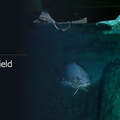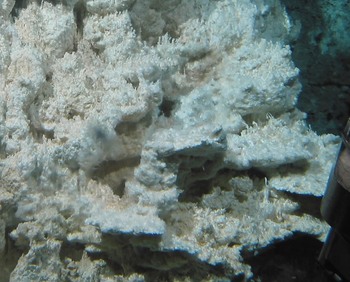Macro-and Meiofaunal Communities: In contrast to dense macrofuanal assemblages that typify most known high-temperature vent environments, the biomass at Lost City is much smaller. The highly scuplted, large surface area of the Lost CIty structures provides ample space for faunal habitats and many invertabrates are located within the porous channels and crevices of the carbonate towers. The animals living within the pores and cracks, however, are generally < 1 cm in size, with transparent to translucent shells that make them difficult to see through the sub windows or with an ROV. Actively venting chimneys (~10-40°C) are dominated by serveral species of gastropods and amphipods. Rare, larger animals include crabs, shrimp, sea urchins, eels and a diverse array of corals. Current assement at Lost CIty shows that ~ 58% of the fauna are endemic to this vent environment [Kelley et al., 2005].
Microorganisms: The Lost City carbonate chimneys host densely-packed populations of cells attached to the carbonates in polymer-encased biofilms where it is presumed they use the high concentrations of H2 and CH4 fluxing from the chimneys. The anoxic, interior zones of the chimneys, where temperatures are 20-90°C and pH is 9-11, harbor biofilms dominated by a single phylotype of archaea - Lost City Methanosarcinales (LCMS) [Schrenk et al., 2004]. Bacteria (phylogenetically related to CH4- and S-oxidizers) are mostly found in the oxygenated outer walls of the chimneys [Brazelton et al., 2006], where fluid chemistry can be substantially different compared to the chimney interiors due to ingress and mixing of seawater with interior vent fluids. Fluid chemistry and biofilm communities indicate that CH4- and S- cycling dominate the ecological processes at Lost City. Results from next-generation pyrosequencing show that the archaeal and bacterial biofilm communities underwent dramatic changes as environmental conditions in the chimneys changed over a 1,000-year period [Brazelton et al., 2010].







